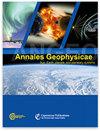High-time-resolution analysis of meridional tides in the upper mesosphere and lower thermosphere at mid-latitudes measured by the Falkland Islands SuperDARN radar
IF 1.9
4区 地球科学
Q3 ASTRONOMY & ASTROPHYSICS
引用次数: 0
Abstract
Abstract. Solar tides play a major role in the dynamics of the upper mesosphere and lower thermosphere (MLT). Hence, a comprehensive understanding of these tides is important for successful modelling of the MLT region. Most ground-based observations of tidal variations in the MLT have been from meteor radar measurements with a temporal resolution of 1 h. Here, we take a different perspective on these tidal variations using high-resolution 1 min neutral-wind measurements from the Falkland Islands SuperDARN (Super Dual Auroral Radar Network) radar. This analysis shows that these higher-resolution data can be used to identify higher frequency tidal components than are typically observed by meteor radars (up to a heptadiurnal component). It also shows evidence of significant power in these higher frequency components, particularly in the quaddiurnal component, which may be particularly suitable for a global analysis using high-resolution SuperDARN neutral-wind measurements. The high-resolution analysis also shows evidence of fluctuations with a frequency of 1.5 cycles per day, as well as higher-frequency fluctuations, accompanying a quasi-2 d (two day) wave. We discuss the limitations of this high-resolution analysis method and the new opportunities that it may provide. We conclude that higher-resolution SuperDARN neutral-wind measurements need to be better exploited in the future as they provide a complementary way of studying tides and waves in the MLT.福克兰群岛超级雷达网雷达测量的中纬度高层中间层和低层热层经向潮的高时间分辨率分析
摘要太阳潮汐在上中间层和下热层(MLT)的动力学中发挥着重要作用。因此,全面了解这些潮汐对于成功建立中层和下热层区域模型非常重要。在这里,我们利用福克兰群岛超级双极光雷达网(Super Dual Auroral Radar Network)雷达提供的 1 分钟高分辨率中性风测量数据,从另一个角度研究这些潮汐变化。分析表明,这些更高分辨率的数据可用于识别比流星雷达通常观测到的频率更高的潮汐成分(高达七日分量)。分析还显示,这些较高频率分量,特别是四昼夜分量,具有很大的功率,可能特别适合于利用高分辨率超级雷达网中性风测量数据进行全球分析。高分辨率分析还显示出频率为每天 1.5 个周期的波动,以及伴随准 2 d(两天)波的更高频率波动。我们讨论了这种高分辨率分析方法的局限性以及它可能提供的新机会。我们的结论是,未来需要更好地利用更高分辨率的 SuperDARN 中性风测量数据,因为它们为研究 MLT 的潮汐和波浪提供了一种补充方法。
本文章由计算机程序翻译,如有差异,请以英文原文为准。
求助全文
约1分钟内获得全文
求助全文
来源期刊

Annales Geophysicae
地学-地球科学综合
CiteScore
4.30
自引率
0.00%
发文量
42
审稿时长
2 months
期刊介绍:
Annales Geophysicae (ANGEO) is a not-for-profit international multi- and inter-disciplinary scientific open-access journal in the field of solar–terrestrial and planetary sciences. ANGEO publishes original articles and short communications (letters) on research of the Sun–Earth system, including the science of space weather, solar–terrestrial plasma physics, the Earth''s ionosphere and atmosphere, the magnetosphere, and the study of planets and planetary systems, the interaction between the different spheres of a planet, and the interaction across the planetary system. Topics range from space weathering, planetary magnetic field, and planetary interior and surface dynamics to the formation and evolution of planetary systems.
 求助内容:
求助内容: 应助结果提醒方式:
应助结果提醒方式:


